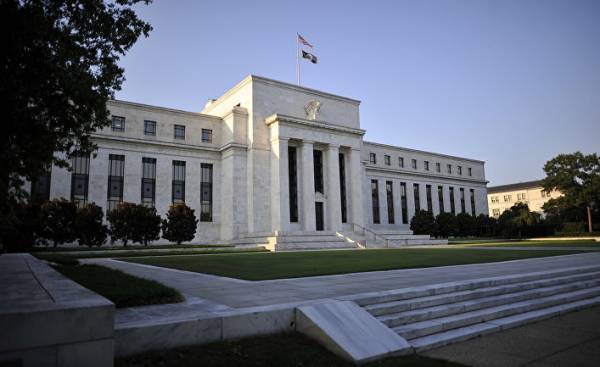
As expected the overwhelming majority of experts, the Federal reserve raised the benchmark interest rate to 0.75-1%. The moment which, in the words of CNBC, “he was waiting all on wall street.” It is not so much to raise the discount rate by a quarter percent, but about trends. It lies in the fact that the discount rate, as they see the experts, will continue to grow, and acceleration.
The “bubble” to the global financial system
First of all, noteworthy is the fact that the current increase is the second in the last four months: this rate has not been since 2006, when there was a boom in the American real estate market. By the way, it then inflated the “bubble” that burst in late 2007, bringing down the entire global financial system.
The fact that the change in American rates is not a local event individual countries. Because the United States is the first economy in the world, which accounts for almost a quarter of global GDP, and the dollar is the global reserve currency, the slightest movement of American rates is reflected across all international markets. The only question is how.
The incident rate hike by the fed a surprise for market players and analysts did not: that such a decision, they were waiting for from the Department chair Janet Yellen.
Recall, the U.S. regulator in December 2008 has set interest rates at 0.25% and in March 2010 they decreased to 0-0. 25%. Such ultra-loose policy was meant to help rebuild the American economy after the recession. The rate increase started in December 2015, when the regulator decided that all the signs of recovery of the financial system is evident.
At the same time, not everyone in the US happy growth rates. Leftist activists called the decision to raise “a huge mistake”, assuming that the data of the American statistics simply do not give grounds for raising rates right now. Critics of the fed motivates its position by the fact that wages in the country is growing too slowly, and millions of people who want to work full time, can’t do that. One is the growth of consumer confidence index, in their opinion, is not enough to raise rates.
At the same time, inflation in the United States, according to the latest data, amounted to 1.9%, which is close to the target of 2%. The situation on the labour market is also good. In February, the number of new jobs increased by 235 thousand, unemployment fell to 4.7%. So the fed also had to rely on in its decision.
Initially, the fed’s policy was not so aggressive, but active actions of the President of the United States Donald trump is to translate campaign promises essentially made adjustments to the plans of the regulator. First of all we are talking about software trump promises to simplify the tax system and reduce the fiscal burden on corporations and citizens. As well as the intention to rapidly restore a running infrastructure of the United States for these purposes is planned to allocate a trillion dollars. If such plans are implemented, it will be a great help for the American economy.
Some analysts believe that the fed’s actions are associated with a peculiar opposition of fed chair Janet Yellen and U.S. President Donald trump because of different views on the economy. In particular, trump was actively campaigning for the repeal of the Dodd-Frank reform of financial regulation, which the fed conducts since 2010.
Frank and Dodd
This act was adopted in order to mitigate the risks of the us financial system, but trump considers it a burden on the budget and the economy as a whole.
In this confrontation also important is the fact that in January, 2018 end of the term Yellen on a post of the Federal reserve, and the new head of the regulator must approve the President. So there is a high probability that the current head of the fed will not remain for a second term.
In Azerbaijan, the dollar will rise
For Azerbaijan, like other developing countries, a new U.S. regulator for a rate hike will mean a rise in the dollar. After all, when the fed increases the discount rate, there is a chain reaction throughout the credit and banking system, increasing the flow of funds in American securities, and as a result the U.S. is growing.
This may be supplemented by additional strengthening of the dollar in the result of cheaper oil — and it is, according to the forecasts of many analysts, will continue. First, inventory of U.S. oil, according to the us Department of energy reached a record level. Second, oil production in the United States increased compared to the previous year by 5% to around 9.1 million barrels per day. Every month the number of drilling rigs, pumping shale oil. According to forecasts, in the coming years, oil production in the U.S. will reach 10 million barrels per day, and approximated to the volume of production of Russia and Saudi Arabia.
Well and, thirdly, the agreement of OPEC countries and other oil-producing States, including Russia, to reduce the volume of oil production is unlikely to be renewed upon expiration of its term in late June. At a recent forum of energy companies in the U.S. the Houston oil Minister of Saudi Arabia and the OPEC Secretary General expressed maloandriivka spirit. It is obvious that the Saudis, which have borne the main burden of reducing oil production to raise prices in the market, dissatisfied with this state of Affairs, believing that the other signatories to fulfill their obligations not enough.
Therefore, it is possible that they will compete with shale oil industry, the US, forcing down the price, using the approved weapons will swing recklessly, lowering prices even more to Americans again became unprofitable to increase the production volumes.
If implemented, this scenario, oil will become cheaper, and the dollar — to go up. Well, the manat will move in the same direction as oil. Good or bad? Anyone.
For example, the Russian government may not be too upset: the budget will receive more rubles, which converted dollar-denominated revenues from oil exports. And the population who have to buy imported products and to change rubles into cheap dollars expensive, for the most part, I think, will be dissatisfied.
The market is feverish
However, the first reaction of markets to the actions of the Federal reserve has been positive: increased us stock indices and, importantly, have increased slightly in the price of oil, which rebounded from a dangerous level of 50 dollars per barrel and were able to overcome the bar at 52.5 dollar.
Experts attribute this to two factors. First and foremost, the speculators have already laid in their quotes the relevant rate hike by the fed and now signaled that “guessed” estimates. The second factor is associated with a specific focused and on track. The market expected a much more harsh statements from the fed, and when they were not made in risky assets has only grown stronger.
By the way, despite the increase in the fed rate, the exchange rate has not changed, although the dollar was significantly stronger, as it occurred after the fed raised the rate in December.
An additional positive aspect that influenced the preservation of the stability of key financial indicators: oil prices and exchange rate, were the data of the International energy Agency about reducing stocks of raw materials in the United States. The decline in the reserves was purely symbolic — only 237 thousand barrels, but even this amount allowed us to push quotes up of hydrocarbons and strengthen the Russian currency, despite the claims of analysts about the current overvaluation of the ruble.
These developments have provided the market a little breathing room. Factor fed intervention into the world economic processes at the time has gone by the wayside. The next meeting of the Board of Directors of the Federal reserve, which will raise the issue of interest rate hike, scheduled for the summer. Then the same issue will be considered at the end of the year. Therefore, in the coming months the price of oil, and the ruble will be shaped not by decisions in Washington, and the traditional, fundamental reasons.
However, this does not mean that the commodity and currency market will not cease to decline. The key factors here – the overabundance of raw materials on the market, the growth or decline in demand, the balance between oil producers — can from time to time to tilt the scales in opposite directions. So what about the medium-term impact of high rate on world markets to talk yet. As for the short-term it was for Moscow and Baku is not so scary and painful as it seemed to many experts before the publication of the decision of the U.S. Federal reserve.







